Comprehensive Report: Hazardous Waste Management and Impacts
VerifiedAdded on 2020/06/06
|16
|5481
|46
Report
AI Summary
This report provides a comprehensive overview of hazardous waste management, encompassing its definition, sources, and classification, along with an analysis of its environmental impacts. The report delves into the origins of hazardous waste, including industrial, agricultural, and domestic sources, while also classifying waste into categories such as listed, characterized, universal, mixed, and e-waste. It highlights the adverse effects of improper waste management on ecosystems and human health. The report also explores various hazardous waste management processes. This report is a valuable resource for understanding the complexities of hazardous waste and the importance of effective management strategies.
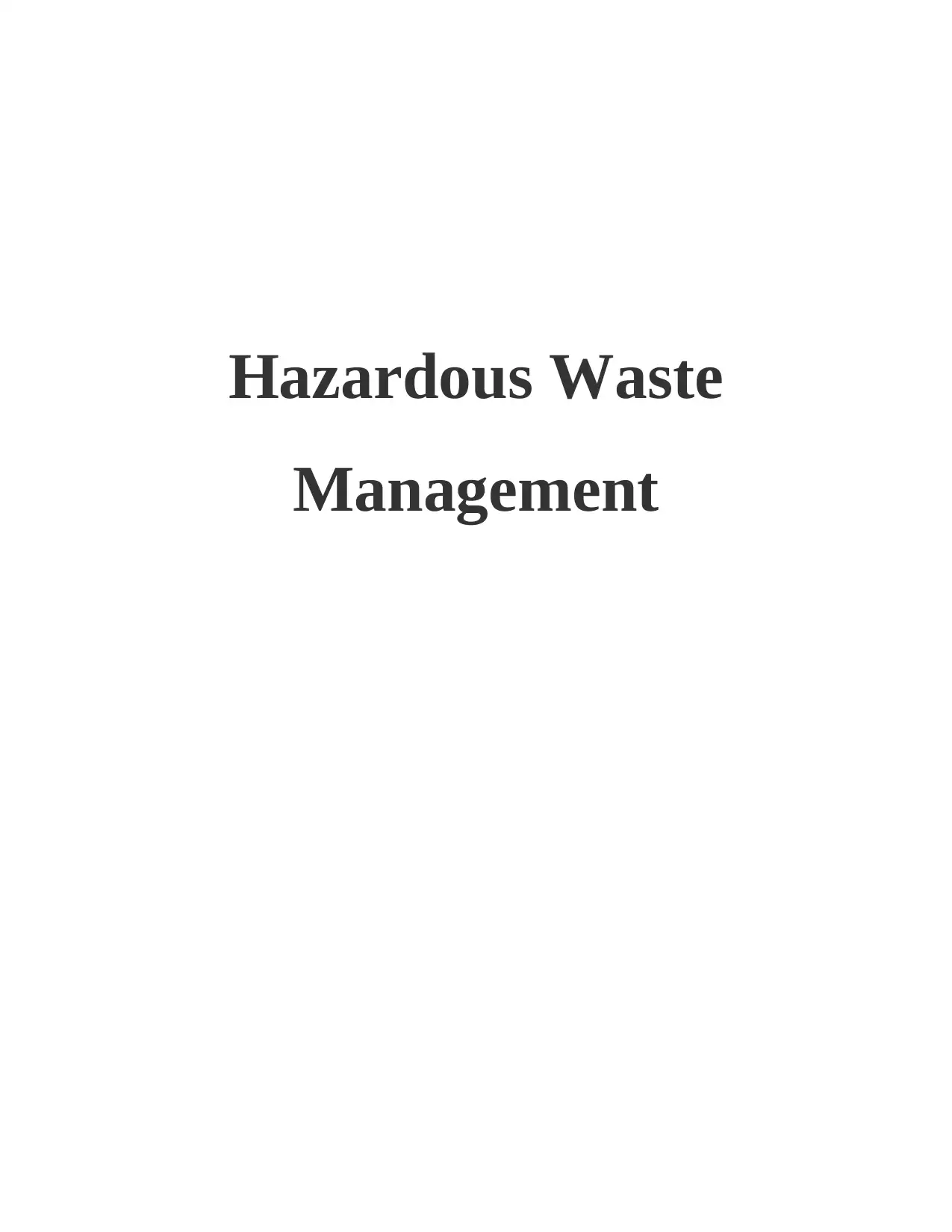
Hazardous Waste
Management
Management
Paraphrase This Document
Need a fresh take? Get an instant paraphrase of this document with our AI Paraphraser
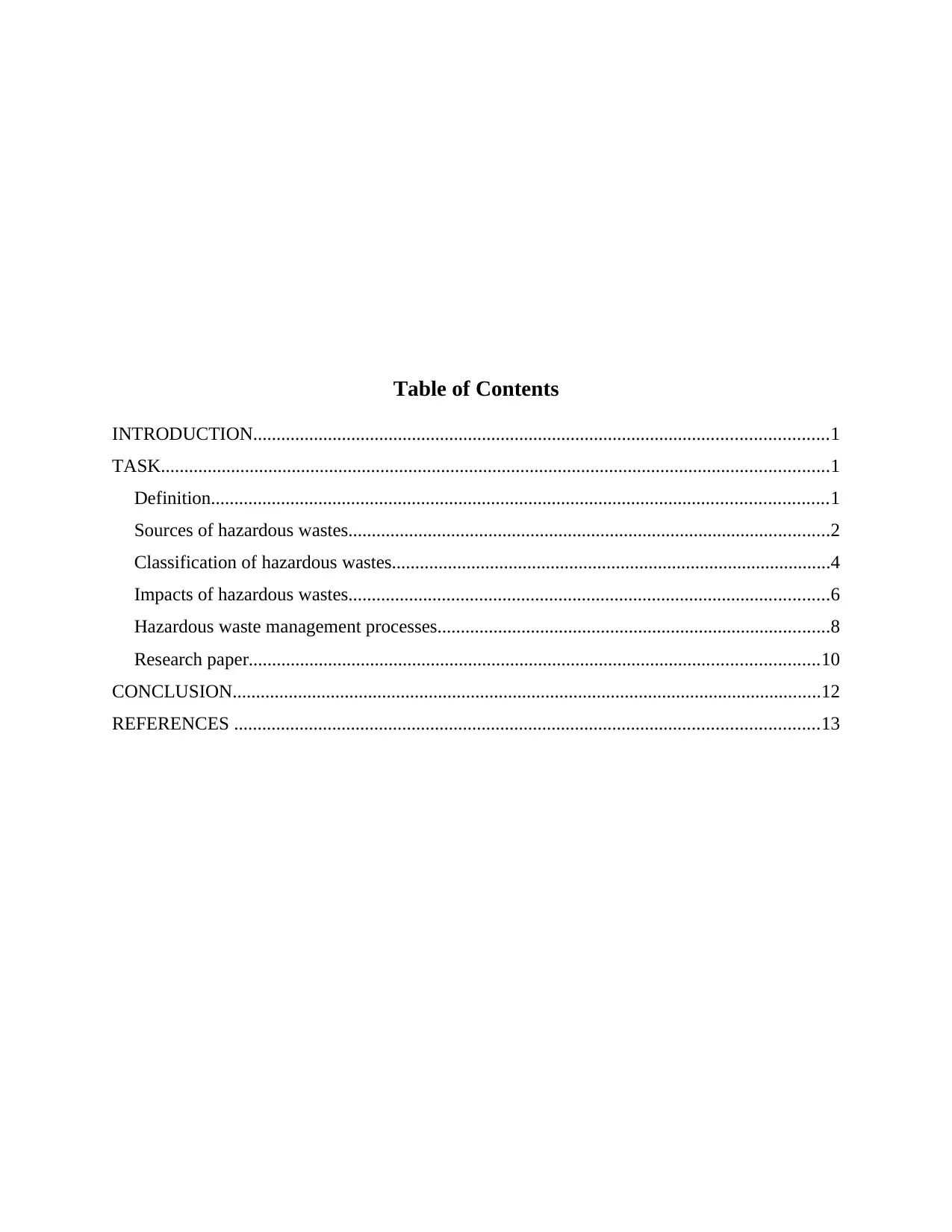
Table of Contents
INTRODUCTION...........................................................................................................................1
TASK...............................................................................................................................................1
Definition....................................................................................................................................1
Sources of hazardous wastes.......................................................................................................2
Classification of hazardous wastes..............................................................................................4
Impacts of hazardous wastes.......................................................................................................6
Hazardous waste management processes....................................................................................8
Research paper..........................................................................................................................10
CONCLUSION..............................................................................................................................12
REFERENCES .............................................................................................................................13
INTRODUCTION...........................................................................................................................1
TASK...............................................................................................................................................1
Definition....................................................................................................................................1
Sources of hazardous wastes.......................................................................................................2
Classification of hazardous wastes..............................................................................................4
Impacts of hazardous wastes.......................................................................................................6
Hazardous waste management processes....................................................................................8
Research paper..........................................................................................................................10
CONCLUSION..............................................................................................................................12
REFERENCES .............................................................................................................................13
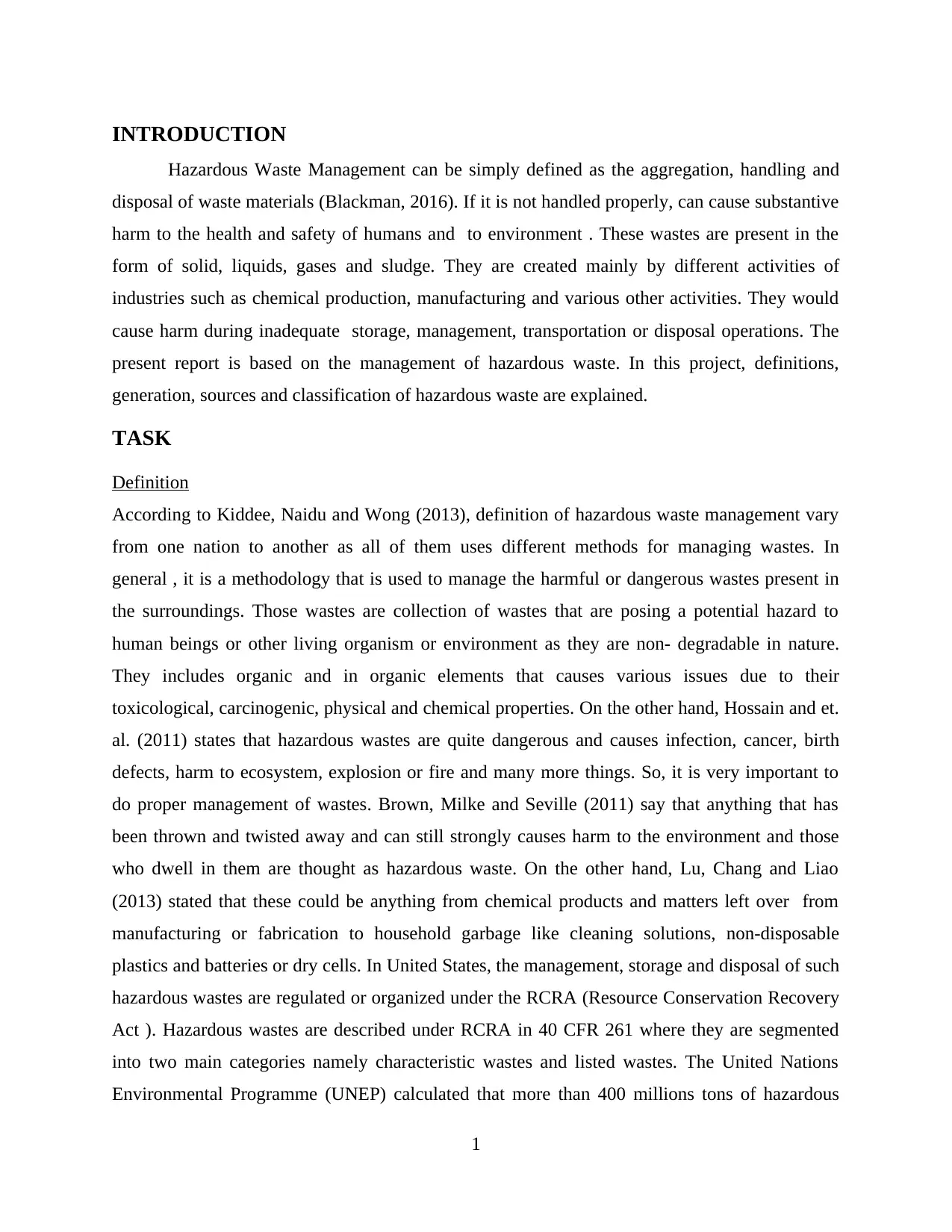
INTRODUCTION
Hazardous Waste Management can be simply defined as the aggregation, handling and
disposal of waste materials (Blackman, 2016). If it is not handled properly, can cause substantive
harm to the health and safety of humans and to environment . These wastes are present in the
form of solid, liquids, gases and sludge. They are created mainly by different activities of
industries such as chemical production, manufacturing and various other activities. They would
cause harm during inadequate storage, management, transportation or disposal operations. The
present report is based on the management of hazardous waste. In this project, definitions,
generation, sources and classification of hazardous waste are explained.
TASK
Definition
According to Kiddee, Naidu and Wong (2013), definition of hazardous waste management vary
from one nation to another as all of them uses different methods for managing wastes. In
general , it is a methodology that is used to manage the harmful or dangerous wastes present in
the surroundings. Those wastes are collection of wastes that are posing a potential hazard to
human beings or other living organism or environment as they are non- degradable in nature.
They includes organic and in organic elements that causes various issues due to their
toxicological, carcinogenic, physical and chemical properties. On the other hand, Hossain and et.
al. (2011) states that hazardous wastes are quite dangerous and causes infection, cancer, birth
defects, harm to ecosystem, explosion or fire and many more things. So, it is very important to
do proper management of wastes. Brown, Milke and Seville (2011) say that anything that has
been thrown and twisted away and can still strongly causes harm to the environment and those
who dwell in them are thought as hazardous waste. On the other hand, Lu, Chang and Liao
(2013) stated that these could be anything from chemical products and matters left over from
manufacturing or fabrication to household garbage like cleaning solutions, non-disposable
plastics and batteries or dry cells. In United States, the management, storage and disposal of such
hazardous wastes are regulated or organized under the RCRA (Resource Conservation Recovery
Act ). Hazardous wastes are described under RCRA in 40 CFR 261 where they are segmented
into two main categories namely characteristic wastes and listed wastes. The United Nations
Environmental Programme (UNEP) calculated that more than 400 millions tons of hazardous
1
Hazardous Waste Management can be simply defined as the aggregation, handling and
disposal of waste materials (Blackman, 2016). If it is not handled properly, can cause substantive
harm to the health and safety of humans and to environment . These wastes are present in the
form of solid, liquids, gases and sludge. They are created mainly by different activities of
industries such as chemical production, manufacturing and various other activities. They would
cause harm during inadequate storage, management, transportation or disposal operations. The
present report is based on the management of hazardous waste. In this project, definitions,
generation, sources and classification of hazardous waste are explained.
TASK
Definition
According to Kiddee, Naidu and Wong (2013), definition of hazardous waste management vary
from one nation to another as all of them uses different methods for managing wastes. In
general , it is a methodology that is used to manage the harmful or dangerous wastes present in
the surroundings. Those wastes are collection of wastes that are posing a potential hazard to
human beings or other living organism or environment as they are non- degradable in nature.
They includes organic and in organic elements that causes various issues due to their
toxicological, carcinogenic, physical and chemical properties. On the other hand, Hossain and et.
al. (2011) states that hazardous wastes are quite dangerous and causes infection, cancer, birth
defects, harm to ecosystem, explosion or fire and many more things. So, it is very important to
do proper management of wastes. Brown, Milke and Seville (2011) say that anything that has
been thrown and twisted away and can still strongly causes harm to the environment and those
who dwell in them are thought as hazardous waste. On the other hand, Lu, Chang and Liao
(2013) stated that these could be anything from chemical products and matters left over from
manufacturing or fabrication to household garbage like cleaning solutions, non-disposable
plastics and batteries or dry cells. In United States, the management, storage and disposal of such
hazardous wastes are regulated or organized under the RCRA (Resource Conservation Recovery
Act ). Hazardous wastes are described under RCRA in 40 CFR 261 where they are segmented
into two main categories namely characteristic wastes and listed wastes. The United Nations
Environmental Programme (UNEP) calculated that more than 400 millions tons of hazardous
1
⊘ This is a preview!⊘
Do you want full access?
Subscribe today to unlock all pages.

Trusted by 1+ million students worldwide
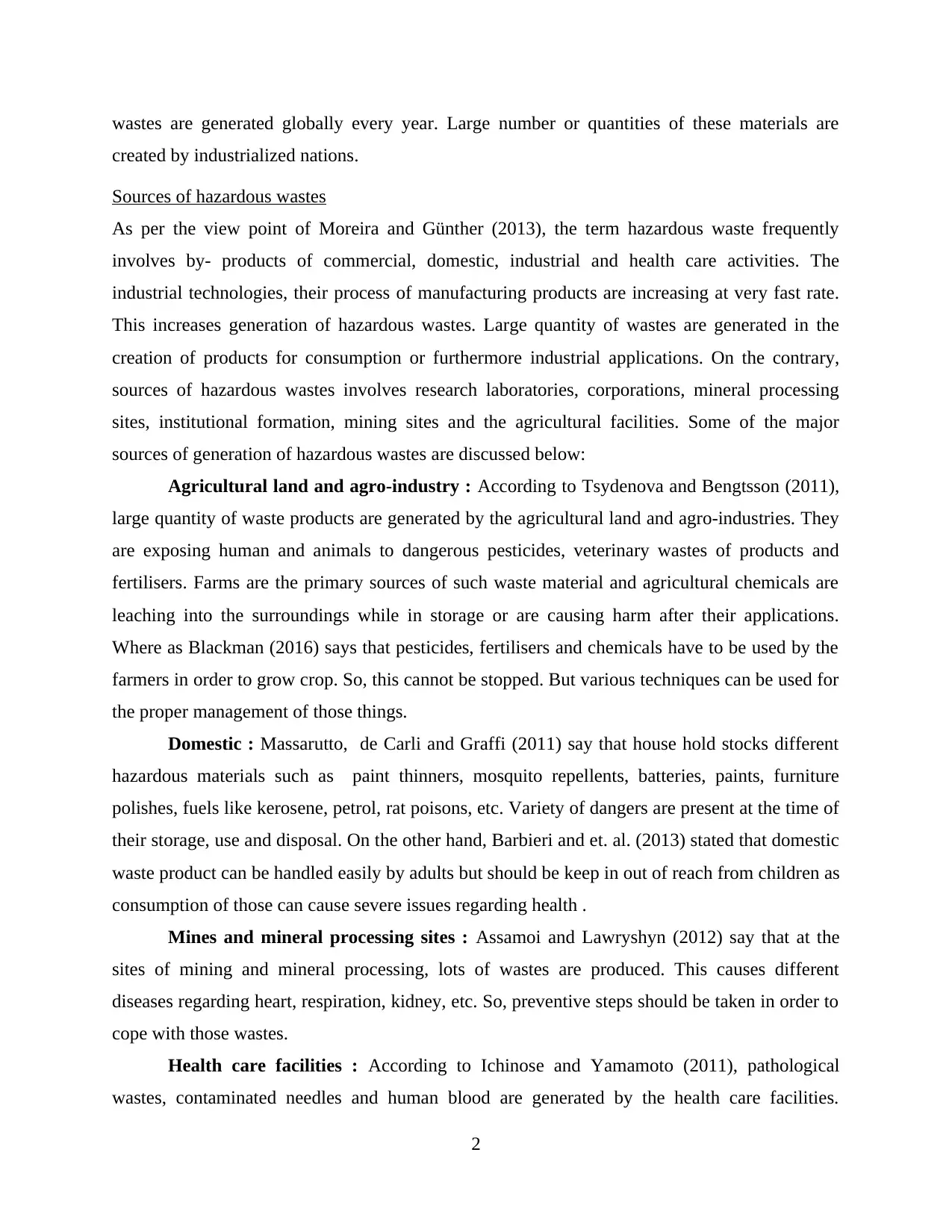
wastes are generated globally every year. Large number or quantities of these materials are
created by industrialized nations.
Sources of hazardous wastes
As per the view point of Moreira and Günther (2013), the term hazardous waste frequently
involves by- products of commercial, domestic, industrial and health care activities. The
industrial technologies, their process of manufacturing products are increasing at very fast rate.
This increases generation of hazardous wastes. Large quantity of wastes are generated in the
creation of products for consumption or furthermore industrial applications. On the contrary,
sources of hazardous wastes involves research laboratories, corporations, mineral processing
sites, institutional formation, mining sites and the agricultural facilities. Some of the major
sources of generation of hazardous wastes are discussed below:
Agricultural land and agro-industry : According to Tsydenova and Bengtsson (2011),
large quantity of waste products are generated by the agricultural land and agro-industries. They
are exposing human and animals to dangerous pesticides, veterinary wastes of products and
fertilisers. Farms are the primary sources of such waste material and agricultural chemicals are
leaching into the surroundings while in storage or are causing harm after their applications.
Where as Blackman (2016) says that pesticides, fertilisers and chemicals have to be used by the
farmers in order to grow crop. So, this cannot be stopped. But various techniques can be used for
the proper management of those things.
Domestic : Massarutto, de Carli and Graffi (2011) say that house hold stocks different
hazardous materials such as paint thinners, mosquito repellents, batteries, paints, furniture
polishes, fuels like kerosene, petrol, rat poisons, etc. Variety of dangers are present at the time of
their storage, use and disposal. On the other hand, Barbieri and et. al. (2013) stated that domestic
waste product can be handled easily by adults but should be keep in out of reach from children as
consumption of those can cause severe issues regarding health .
Mines and mineral processing sites : Assamoi and Lawryshyn (2012) say that at the
sites of mining and mineral processing, lots of wastes are produced. This causes different
diseases regarding heart, respiration, kidney, etc. So, preventive steps should be taken in order to
cope with those wastes.
Health care facilities : According to Ichinose and Yamamoto (2011), pathological
wastes, contaminated needles and human blood are generated by the health care facilities.
2
created by industrialized nations.
Sources of hazardous wastes
As per the view point of Moreira and Günther (2013), the term hazardous waste frequently
involves by- products of commercial, domestic, industrial and health care activities. The
industrial technologies, their process of manufacturing products are increasing at very fast rate.
This increases generation of hazardous wastes. Large quantity of wastes are generated in the
creation of products for consumption or furthermore industrial applications. On the contrary,
sources of hazardous wastes involves research laboratories, corporations, mineral processing
sites, institutional formation, mining sites and the agricultural facilities. Some of the major
sources of generation of hazardous wastes are discussed below:
Agricultural land and agro-industry : According to Tsydenova and Bengtsson (2011),
large quantity of waste products are generated by the agricultural land and agro-industries. They
are exposing human and animals to dangerous pesticides, veterinary wastes of products and
fertilisers. Farms are the primary sources of such waste material and agricultural chemicals are
leaching into the surroundings while in storage or are causing harm after their applications.
Where as Blackman (2016) says that pesticides, fertilisers and chemicals have to be used by the
farmers in order to grow crop. So, this cannot be stopped. But various techniques can be used for
the proper management of those things.
Domestic : Massarutto, de Carli and Graffi (2011) say that house hold stocks different
hazardous materials such as paint thinners, mosquito repellents, batteries, paints, furniture
polishes, fuels like kerosene, petrol, rat poisons, etc. Variety of dangers are present at the time of
their storage, use and disposal. On the other hand, Barbieri and et. al. (2013) stated that domestic
waste product can be handled easily by adults but should be keep in out of reach from children as
consumption of those can cause severe issues regarding health .
Mines and mineral processing sites : Assamoi and Lawryshyn (2012) say that at the
sites of mining and mineral processing, lots of wastes are produced. This causes different
diseases regarding heart, respiration, kidney, etc. So, preventive steps should be taken in order to
cope with those wastes.
Health care facilities : According to Ichinose and Yamamoto (2011), pathological
wastes, contaminated needles and human blood are generated by the health care facilities.
2
Paraphrase This Document
Need a fresh take? Get an instant paraphrase of this document with our AI Paraphraser
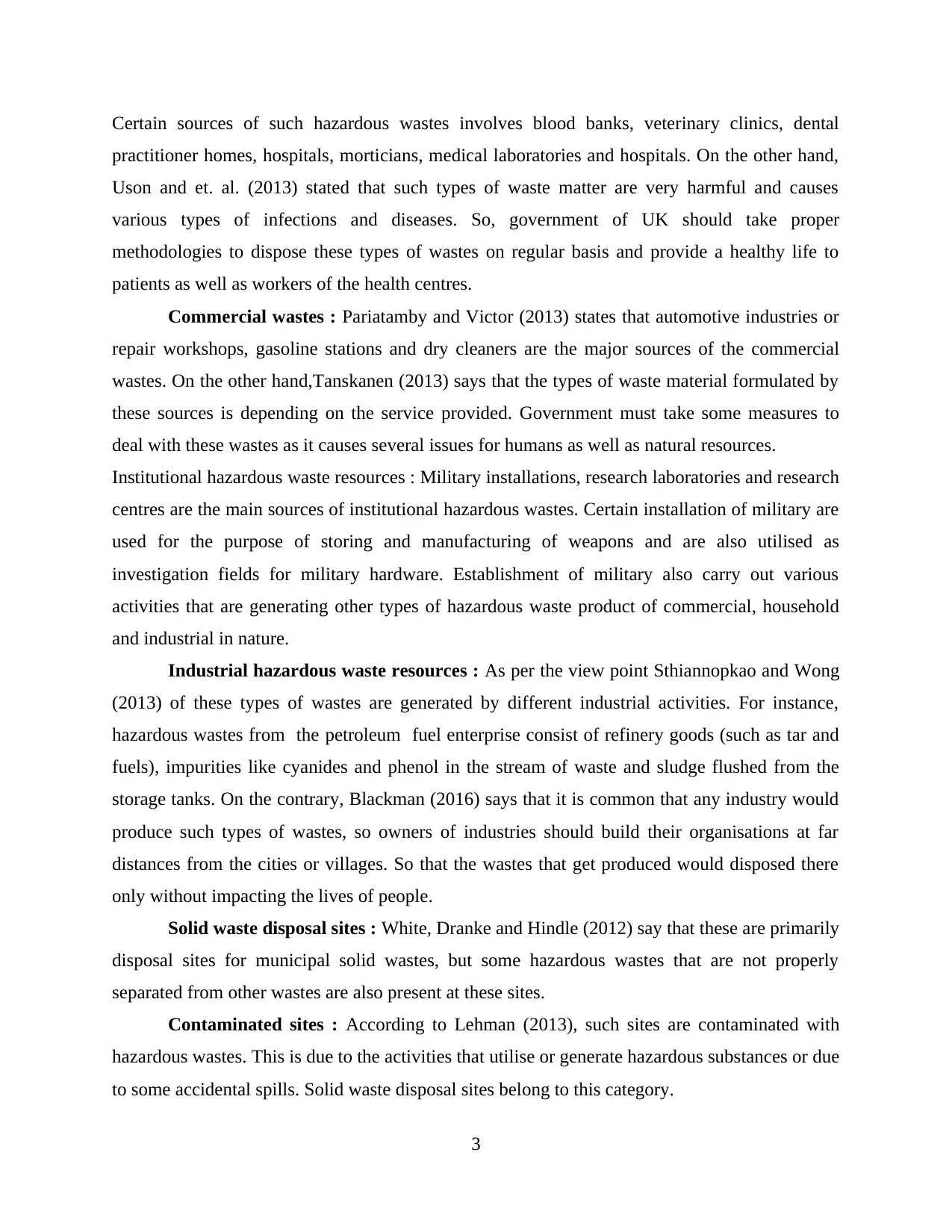
Certain sources of such hazardous wastes involves blood banks, veterinary clinics, dental
practitioner homes, hospitals, morticians, medical laboratories and hospitals. On the other hand,
Uson and et. al. (2013) stated that such types of waste matter are very harmful and causes
various types of infections and diseases. So, government of UK should take proper
methodologies to dispose these types of wastes on regular basis and provide a healthy life to
patients as well as workers of the health centres.
Commercial wastes : Pariatamby and Victor (2013) states that automotive industries or
repair workshops, gasoline stations and dry cleaners are the major sources of the commercial
wastes. On the other hand,Tanskanen (2013) says that the types of waste material formulated by
these sources is depending on the service provided. Government must take some measures to
deal with these wastes as it causes several issues for humans as well as natural resources.
Institutional hazardous waste resources : Military installations, research laboratories and research
centres are the main sources of institutional hazardous wastes. Certain installation of military are
used for the purpose of storing and manufacturing of weapons and are also utilised as
investigation fields for military hardware. Establishment of military also carry out various
activities that are generating other types of hazardous waste product of commercial, household
and industrial in nature.
Industrial hazardous waste resources : As per the view point Sthiannopkao and Wong
(2013) of these types of wastes are generated by different industrial activities. For instance,
hazardous wastes from the petroleum fuel enterprise consist of refinery goods (such as tar and
fuels), impurities like cyanides and phenol in the stream of waste and sludge flushed from the
storage tanks. On the contrary, Blackman (2016) says that it is common that any industry would
produce such types of wastes, so owners of industries should build their organisations at far
distances from the cities or villages. So that the wastes that get produced would disposed there
only without impacting the lives of people.
Solid waste disposal sites : White, Dranke and Hindle (2012) say that these are primarily
disposal sites for municipal solid wastes, but some hazardous wastes that are not properly
separated from other wastes are also present at these sites.
Contaminated sites : According to Lehman (2013), such sites are contaminated with
hazardous wastes. This is due to the activities that utilise or generate hazardous substances or due
to some accidental spills. Solid waste disposal sites belong to this category.
3
practitioner homes, hospitals, morticians, medical laboratories and hospitals. On the other hand,
Uson and et. al. (2013) stated that such types of waste matter are very harmful and causes
various types of infections and diseases. So, government of UK should take proper
methodologies to dispose these types of wastes on regular basis and provide a healthy life to
patients as well as workers of the health centres.
Commercial wastes : Pariatamby and Victor (2013) states that automotive industries or
repair workshops, gasoline stations and dry cleaners are the major sources of the commercial
wastes. On the other hand,Tanskanen (2013) says that the types of waste material formulated by
these sources is depending on the service provided. Government must take some measures to
deal with these wastes as it causes several issues for humans as well as natural resources.
Institutional hazardous waste resources : Military installations, research laboratories and research
centres are the main sources of institutional hazardous wastes. Certain installation of military are
used for the purpose of storing and manufacturing of weapons and are also utilised as
investigation fields for military hardware. Establishment of military also carry out various
activities that are generating other types of hazardous waste product of commercial, household
and industrial in nature.
Industrial hazardous waste resources : As per the view point Sthiannopkao and Wong
(2013) of these types of wastes are generated by different industrial activities. For instance,
hazardous wastes from the petroleum fuel enterprise consist of refinery goods (such as tar and
fuels), impurities like cyanides and phenol in the stream of waste and sludge flushed from the
storage tanks. On the contrary, Blackman (2016) says that it is common that any industry would
produce such types of wastes, so owners of industries should build their organisations at far
distances from the cities or villages. So that the wastes that get produced would disposed there
only without impacting the lives of people.
Solid waste disposal sites : White, Dranke and Hindle (2012) say that these are primarily
disposal sites for municipal solid wastes, but some hazardous wastes that are not properly
separated from other wastes are also present at these sites.
Contaminated sites : According to Lehman (2013), such sites are contaminated with
hazardous wastes. This is due to the activities that utilise or generate hazardous substances or due
to some accidental spills. Solid waste disposal sites belong to this category.
3
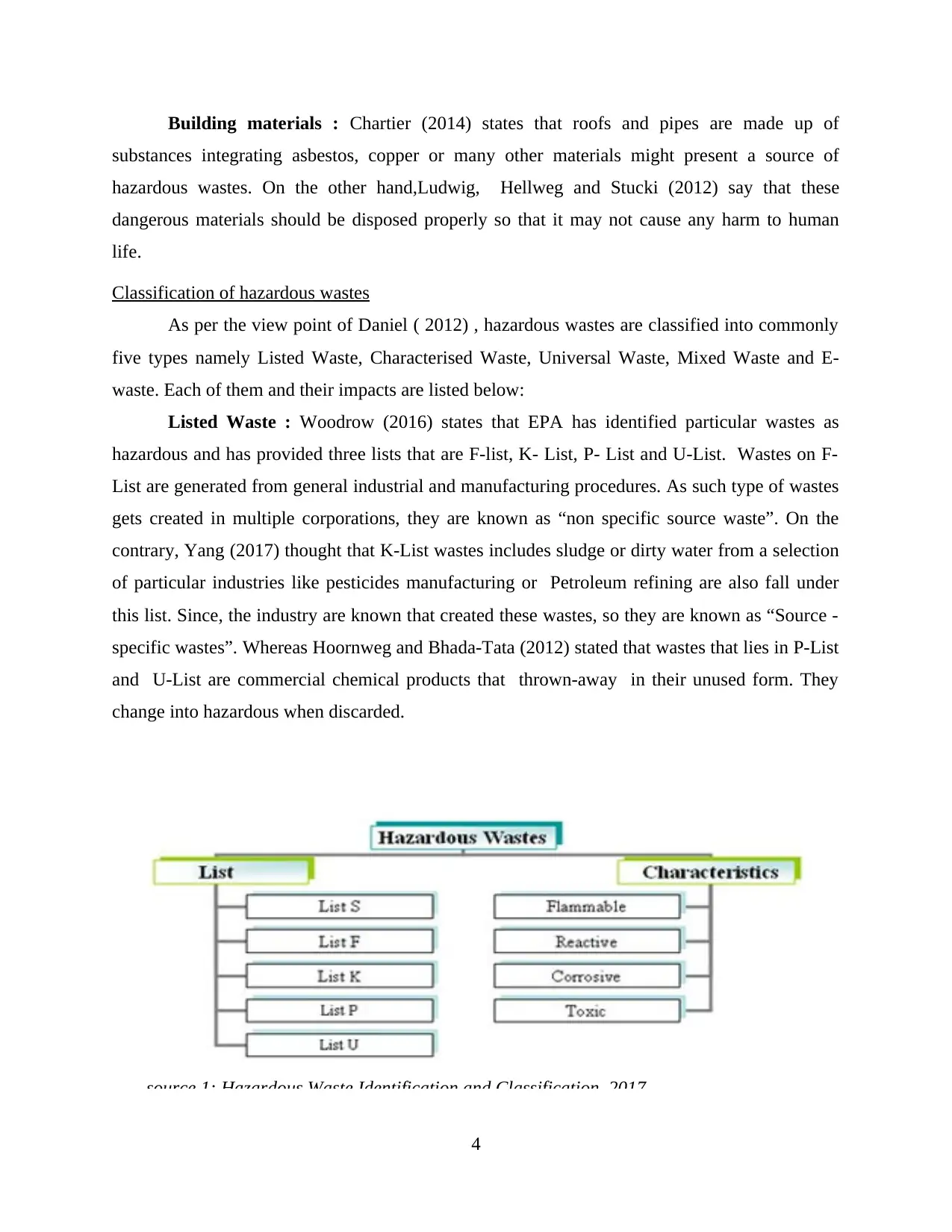
Building materials : Chartier (2014) states that roofs and pipes are made up of
substances integrating asbestos, copper or many other materials might present a source of
hazardous wastes. On the other hand,Ludwig, Hellweg and Stucki (2012) say that these
dangerous materials should be disposed properly so that it may not cause any harm to human
life.
Classification of hazardous wastes
As per the view point of Daniel ( 2012) , hazardous wastes are classified into commonly
five types namely Listed Waste, Characterised Waste, Universal Waste, Mixed Waste and E-
waste. Each of them and their impacts are listed below:
Listed Waste : Woodrow (2016) states that EPA has identified particular wastes as
hazardous and has provided three lists that are F-list, K- List, P- List and U-List. Wastes on F-
List are generated from general industrial and manufacturing procedures. As such type of wastes
gets created in multiple corporations, they are known as “non specific source waste”. On the
contrary, Yang (2017) thought that K-List wastes includes sludge or dirty water from a selection
of particular industries like pesticides manufacturing or Petroleum refining are also fall under
this list. Since, the industry are known that created these wastes, so they are known as “Source -
specific wastes”. Whereas Hoornweg and Bhada-Tata (2012) stated that wastes that lies in P-List
and U-List are commercial chemical products that thrown-away in their unused form. They
change into hazardous when discarded.
4
source 1: Hazardous Waste Identification and Classification ,2017
substances integrating asbestos, copper or many other materials might present a source of
hazardous wastes. On the other hand,Ludwig, Hellweg and Stucki (2012) say that these
dangerous materials should be disposed properly so that it may not cause any harm to human
life.
Classification of hazardous wastes
As per the view point of Daniel ( 2012) , hazardous wastes are classified into commonly
five types namely Listed Waste, Characterised Waste, Universal Waste, Mixed Waste and E-
waste. Each of them and their impacts are listed below:
Listed Waste : Woodrow (2016) states that EPA has identified particular wastes as
hazardous and has provided three lists that are F-list, K- List, P- List and U-List. Wastes on F-
List are generated from general industrial and manufacturing procedures. As such type of wastes
gets created in multiple corporations, they are known as “non specific source waste”. On the
contrary, Yang (2017) thought that K-List wastes includes sludge or dirty water from a selection
of particular industries like pesticides manufacturing or Petroleum refining are also fall under
this list. Since, the industry are known that created these wastes, so they are known as “Source -
specific wastes”. Whereas Hoornweg and Bhada-Tata (2012) stated that wastes that lies in P-List
and U-List are commercial chemical products that thrown-away in their unused form. They
change into hazardous when discarded.
4
source 1: Hazardous Waste Identification and Classification ,2017
⊘ This is a preview!⊘
Do you want full access?
Subscribe today to unlock all pages.

Trusted by 1+ million students worldwide
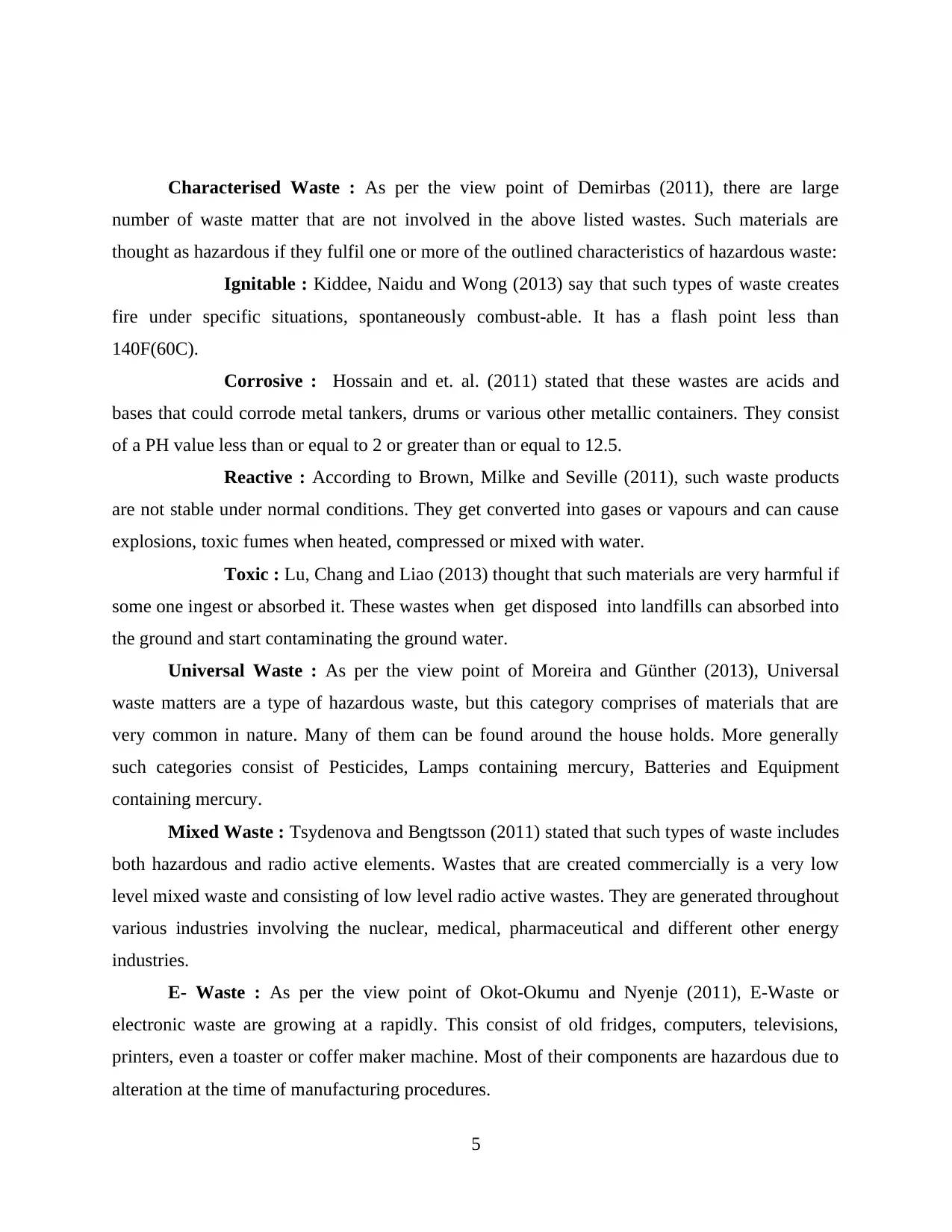
Characterised Waste : As per the view point of Demirbas (2011), there are large
number of waste matter that are not involved in the above listed wastes. Such materials are
thought as hazardous if they fulfil one or more of the outlined characteristics of hazardous waste:
Ignitable : Kiddee, Naidu and Wong (2013) say that such types of waste creates
fire under specific situations, spontaneously combust-able. It has a flash point less than
140F(60C).
Corrosive : Hossain and et. al. (2011) stated that these wastes are acids and
bases that could corrode metal tankers, drums or various other metallic containers. They consist
of a PH value less than or equal to 2 or greater than or equal to 12.5.
Reactive : According to Brown, Milke and Seville (2011), such waste products
are not stable under normal conditions. They get converted into gases or vapours and can cause
explosions, toxic fumes when heated, compressed or mixed with water.
Toxic : Lu, Chang and Liao (2013) thought that such materials are very harmful if
some one ingest or absorbed it. These wastes when get disposed into landfills can absorbed into
the ground and start contaminating the ground water.
Universal Waste : As per the view point of Moreira and Günther (2013), Universal
waste matters are a type of hazardous waste, but this category comprises of materials that are
very common in nature. Many of them can be found around the house holds. More generally
such categories consist of Pesticides, Lamps containing mercury, Batteries and Equipment
containing mercury.
Mixed Waste : Tsydenova and Bengtsson (2011) stated that such types of waste includes
both hazardous and radio active elements. Wastes that are created commercially is a very low
level mixed waste and consisting of low level radio active wastes. They are generated throughout
various industries involving the nuclear, medical, pharmaceutical and different other energy
industries.
E- Waste : As per the view point of Okot-Okumu and Nyenje (2011), E-Waste or
electronic waste are growing at a rapidly. This consist of old fridges, computers, televisions,
printers, even a toaster or coffer maker machine. Most of their components are hazardous due to
alteration at the time of manufacturing procedures.
5
number of waste matter that are not involved in the above listed wastes. Such materials are
thought as hazardous if they fulfil one or more of the outlined characteristics of hazardous waste:
Ignitable : Kiddee, Naidu and Wong (2013) say that such types of waste creates
fire under specific situations, spontaneously combust-able. It has a flash point less than
140F(60C).
Corrosive : Hossain and et. al. (2011) stated that these wastes are acids and
bases that could corrode metal tankers, drums or various other metallic containers. They consist
of a PH value less than or equal to 2 or greater than or equal to 12.5.
Reactive : According to Brown, Milke and Seville (2011), such waste products
are not stable under normal conditions. They get converted into gases or vapours and can cause
explosions, toxic fumes when heated, compressed or mixed with water.
Toxic : Lu, Chang and Liao (2013) thought that such materials are very harmful if
some one ingest or absorbed it. These wastes when get disposed into landfills can absorbed into
the ground and start contaminating the ground water.
Universal Waste : As per the view point of Moreira and Günther (2013), Universal
waste matters are a type of hazardous waste, but this category comprises of materials that are
very common in nature. Many of them can be found around the house holds. More generally
such categories consist of Pesticides, Lamps containing mercury, Batteries and Equipment
containing mercury.
Mixed Waste : Tsydenova and Bengtsson (2011) stated that such types of waste includes
both hazardous and radio active elements. Wastes that are created commercially is a very low
level mixed waste and consisting of low level radio active wastes. They are generated throughout
various industries involving the nuclear, medical, pharmaceutical and different other energy
industries.
E- Waste : As per the view point of Okot-Okumu and Nyenje (2011), E-Waste or
electronic waste are growing at a rapidly. This consist of old fridges, computers, televisions,
printers, even a toaster or coffer maker machine. Most of their components are hazardous due to
alteration at the time of manufacturing procedures.
5
Paraphrase This Document
Need a fresh take? Get an instant paraphrase of this document with our AI Paraphraser
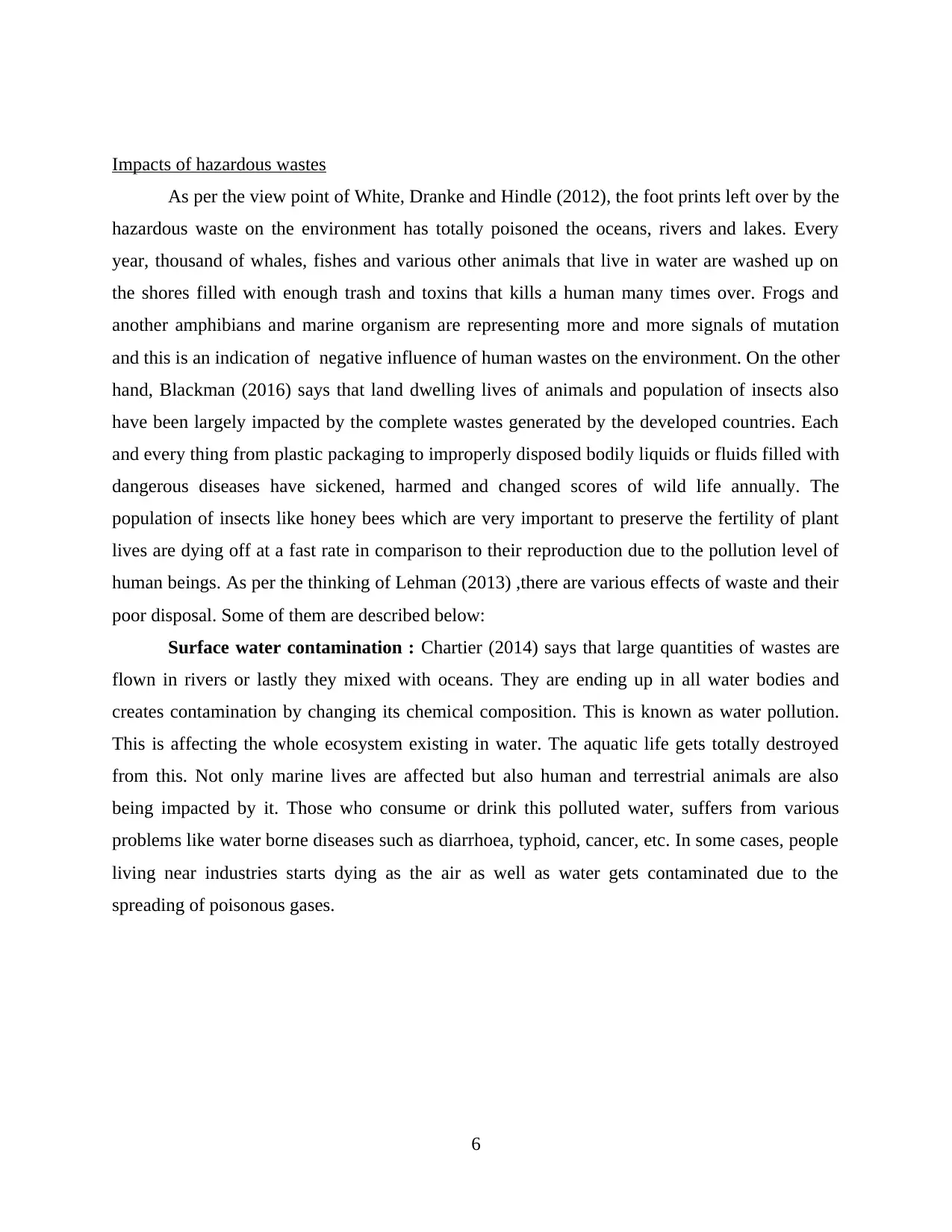
Impacts of hazardous wastes
As per the view point of White, Dranke and Hindle (2012), the foot prints left over by the
hazardous waste on the environment has totally poisoned the oceans, rivers and lakes. Every
year, thousand of whales, fishes and various other animals that live in water are washed up on
the shores filled with enough trash and toxins that kills a human many times over. Frogs and
another amphibians and marine organism are representing more and more signals of mutation
and this is an indication of negative influence of human wastes on the environment. On the other
hand, Blackman (2016) says that land dwelling lives of animals and population of insects also
have been largely impacted by the complete wastes generated by the developed countries. Each
and every thing from plastic packaging to improperly disposed bodily liquids or fluids filled with
dangerous diseases have sickened, harmed and changed scores of wild life annually. The
population of insects like honey bees which are very important to preserve the fertility of plant
lives are dying off at a fast rate in comparison to their reproduction due to the pollution level of
human beings. As per the thinking of Lehman (2013) ,there are various effects of waste and their
poor disposal. Some of them are described below:
Surface water contamination : Chartier (2014) says that large quantities of wastes are
flown in rivers or lastly they mixed with oceans. They are ending up in all water bodies and
creates contamination by changing its chemical composition. This is known as water pollution.
This is affecting the whole ecosystem existing in water. The aquatic life gets totally destroyed
from this. Not only marine lives are affected but also human and terrestrial animals are also
being impacted by it. Those who consume or drink this polluted water, suffers from various
problems like water borne diseases such as diarrhoea, typhoid, cancer, etc. In some cases, people
living near industries starts dying as the air as well as water gets contaminated due to the
spreading of poisonous gases.
6
As per the view point of White, Dranke and Hindle (2012), the foot prints left over by the
hazardous waste on the environment has totally poisoned the oceans, rivers and lakes. Every
year, thousand of whales, fishes and various other animals that live in water are washed up on
the shores filled with enough trash and toxins that kills a human many times over. Frogs and
another amphibians and marine organism are representing more and more signals of mutation
and this is an indication of negative influence of human wastes on the environment. On the other
hand, Blackman (2016) says that land dwelling lives of animals and population of insects also
have been largely impacted by the complete wastes generated by the developed countries. Each
and every thing from plastic packaging to improperly disposed bodily liquids or fluids filled with
dangerous diseases have sickened, harmed and changed scores of wild life annually. The
population of insects like honey bees which are very important to preserve the fertility of plant
lives are dying off at a fast rate in comparison to their reproduction due to the pollution level of
human beings. As per the thinking of Lehman (2013) ,there are various effects of waste and their
poor disposal. Some of them are described below:
Surface water contamination : Chartier (2014) says that large quantities of wastes are
flown in rivers or lastly they mixed with oceans. They are ending up in all water bodies and
creates contamination by changing its chemical composition. This is known as water pollution.
This is affecting the whole ecosystem existing in water. The aquatic life gets totally destroyed
from this. Not only marine lives are affected but also human and terrestrial animals are also
being impacted by it. Those who consume or drink this polluted water, suffers from various
problems like water borne diseases such as diarrhoea, typhoid, cancer, etc. In some cases, people
living near industries starts dying as the air as well as water gets contaminated due to the
spreading of poisonous gases.
6
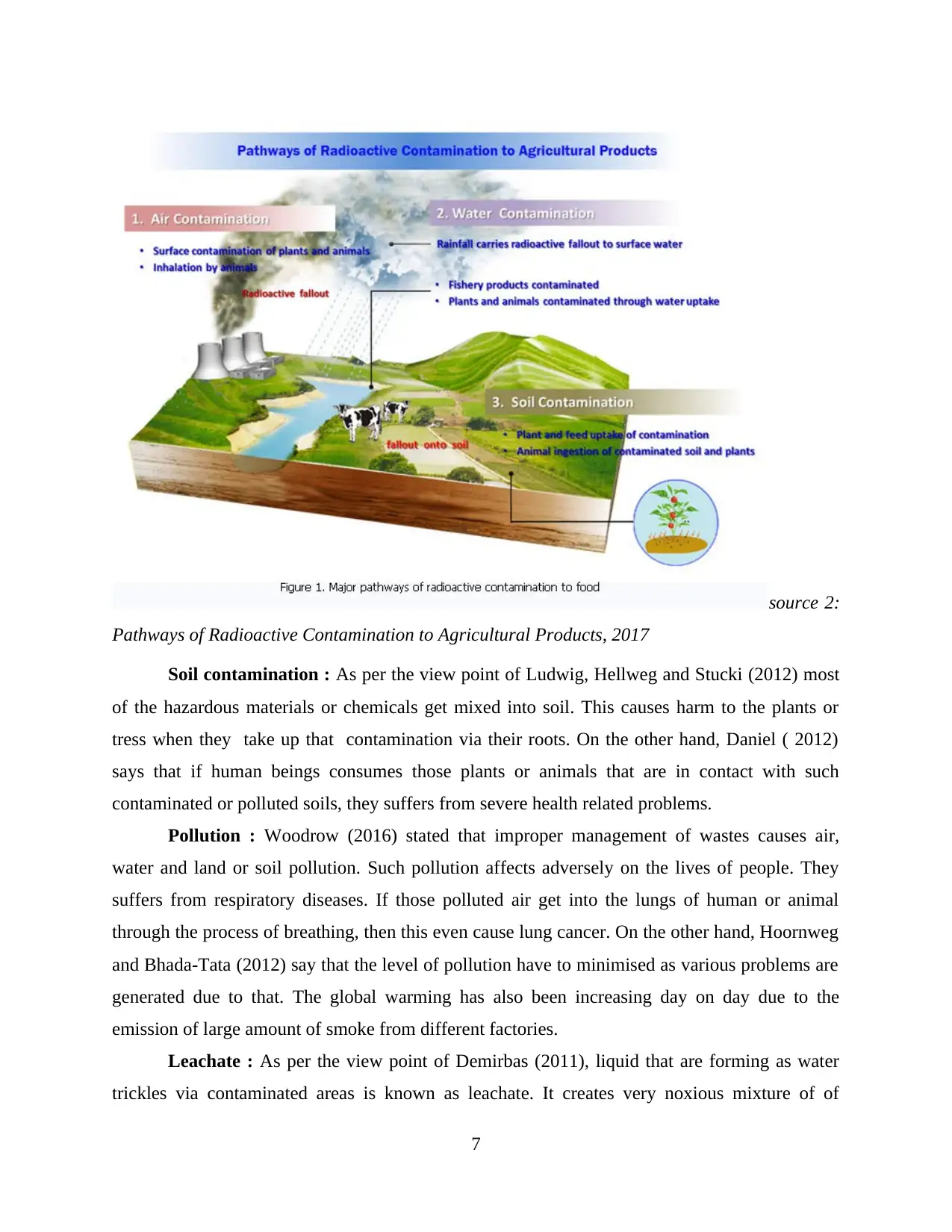
Soil contamination : As per the view point of Ludwig, Hellweg and Stucki (2012) most
of the hazardous materials or chemicals get mixed into soil. This causes harm to the plants or
tress when they take up that contamination via their roots. On the other hand, Daniel ( 2012)
says that if human beings consumes those plants or animals that are in contact with such
contaminated or polluted soils, they suffers from severe health related problems.
Pollution : Woodrow (2016) stated that improper management of wastes causes air,
water and land or soil pollution. Such pollution affects adversely on the lives of people. They
suffers from respiratory diseases. If those polluted air get into the lungs of human or animal
through the process of breathing, then this even cause lung cancer. On the other hand, Hoornweg
and Bhada-Tata (2012) say that the level of pollution have to minimised as various problems are
generated due to that. The global warming has also been increasing day on day due to the
emission of large amount of smoke from different factories.
Leachate : As per the view point of Demirbas (2011), liquid that are forming as water
trickles via contaminated areas is known as leachate. It creates very noxious mixture of of
7
source 2:
Pathways of Radioactive Contamination to Agricultural Products, 2017
of the hazardous materials or chemicals get mixed into soil. This causes harm to the plants or
tress when they take up that contamination via their roots. On the other hand, Daniel ( 2012)
says that if human beings consumes those plants or animals that are in contact with such
contaminated or polluted soils, they suffers from severe health related problems.
Pollution : Woodrow (2016) stated that improper management of wastes causes air,
water and land or soil pollution. Such pollution affects adversely on the lives of people. They
suffers from respiratory diseases. If those polluted air get into the lungs of human or animal
through the process of breathing, then this even cause lung cancer. On the other hand, Hoornweg
and Bhada-Tata (2012) say that the level of pollution have to minimised as various problems are
generated due to that. The global warming has also been increasing day on day due to the
emission of large amount of smoke from different factories.
Leachate : As per the view point of Demirbas (2011), liquid that are forming as water
trickles via contaminated areas is known as leachate. It creates very noxious mixture of of
7
source 2:
Pathways of Radioactive Contamination to Agricultural Products, 2017
⊘ This is a preview!⊘
Do you want full access?
Subscribe today to unlock all pages.

Trusted by 1+ million students worldwide
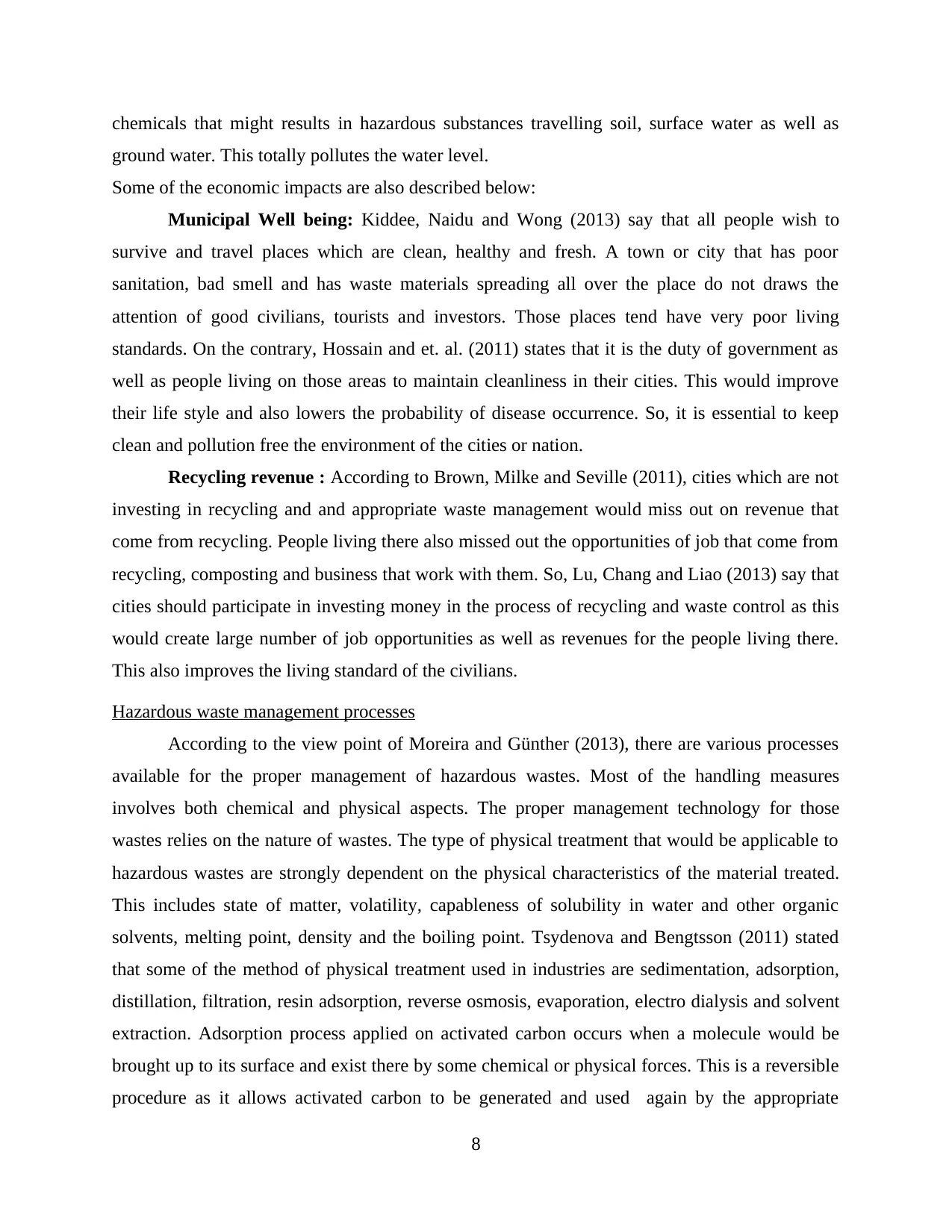
chemicals that might results in hazardous substances travelling soil, surface water as well as
ground water. This totally pollutes the water level.
Some of the economic impacts are also described below:
Municipal Well being: Kiddee, Naidu and Wong (2013) say that all people wish to
survive and travel places which are clean, healthy and fresh. A town or city that has poor
sanitation, bad smell and has waste materials spreading all over the place do not draws the
attention of good civilians, tourists and investors. Those places tend have very poor living
standards. On the contrary, Hossain and et. al. (2011) states that it is the duty of government as
well as people living on those areas to maintain cleanliness in their cities. This would improve
their life style and also lowers the probability of disease occurrence. So, it is essential to keep
clean and pollution free the environment of the cities or nation.
Recycling revenue : According to Brown, Milke and Seville (2011), cities which are not
investing in recycling and and appropriate waste management would miss out on revenue that
come from recycling. People living there also missed out the opportunities of job that come from
recycling, composting and business that work with them. So, Lu, Chang and Liao (2013) say that
cities should participate in investing money in the process of recycling and waste control as this
would create large number of job opportunities as well as revenues for the people living there.
This also improves the living standard of the civilians.
Hazardous waste management processes
According to the view point of Moreira and Günther (2013), there are various processes
available for the proper management of hazardous wastes. Most of the handling measures
involves both chemical and physical aspects. The proper management technology for those
wastes relies on the nature of wastes. The type of physical treatment that would be applicable to
hazardous wastes are strongly dependent on the physical characteristics of the material treated.
This includes state of matter, volatility, capableness of solubility in water and other organic
solvents, melting point, density and the boiling point. Tsydenova and Bengtsson (2011) stated
that some of the method of physical treatment used in industries are sedimentation, adsorption,
distillation, filtration, resin adsorption, reverse osmosis, evaporation, electro dialysis and solvent
extraction. Adsorption process applied on activated carbon occurs when a molecule would be
brought up to its surface and exist there by some chemical or physical forces. This is a reversible
procedure as it allows activated carbon to be generated and used again by the appropriate
8
ground water. This totally pollutes the water level.
Some of the economic impacts are also described below:
Municipal Well being: Kiddee, Naidu and Wong (2013) say that all people wish to
survive and travel places which are clean, healthy and fresh. A town or city that has poor
sanitation, bad smell and has waste materials spreading all over the place do not draws the
attention of good civilians, tourists and investors. Those places tend have very poor living
standards. On the contrary, Hossain and et. al. (2011) states that it is the duty of government as
well as people living on those areas to maintain cleanliness in their cities. This would improve
their life style and also lowers the probability of disease occurrence. So, it is essential to keep
clean and pollution free the environment of the cities or nation.
Recycling revenue : According to Brown, Milke and Seville (2011), cities which are not
investing in recycling and and appropriate waste management would miss out on revenue that
come from recycling. People living there also missed out the opportunities of job that come from
recycling, composting and business that work with them. So, Lu, Chang and Liao (2013) say that
cities should participate in investing money in the process of recycling and waste control as this
would create large number of job opportunities as well as revenues for the people living there.
This also improves the living standard of the civilians.
Hazardous waste management processes
According to the view point of Moreira and Günther (2013), there are various processes
available for the proper management of hazardous wastes. Most of the handling measures
involves both chemical and physical aspects. The proper management technology for those
wastes relies on the nature of wastes. The type of physical treatment that would be applicable to
hazardous wastes are strongly dependent on the physical characteristics of the material treated.
This includes state of matter, volatility, capableness of solubility in water and other organic
solvents, melting point, density and the boiling point. Tsydenova and Bengtsson (2011) stated
that some of the method of physical treatment used in industries are sedimentation, adsorption,
distillation, filtration, resin adsorption, reverse osmosis, evaporation, electro dialysis and solvent
extraction. Adsorption process applied on activated carbon occurs when a molecule would be
brought up to its surface and exist there by some chemical or physical forces. This is a reversible
procedure as it allows activated carbon to be generated and used again by the appropriate
8
Paraphrase This Document
Need a fresh take? Get an instant paraphrase of this document with our AI Paraphraser
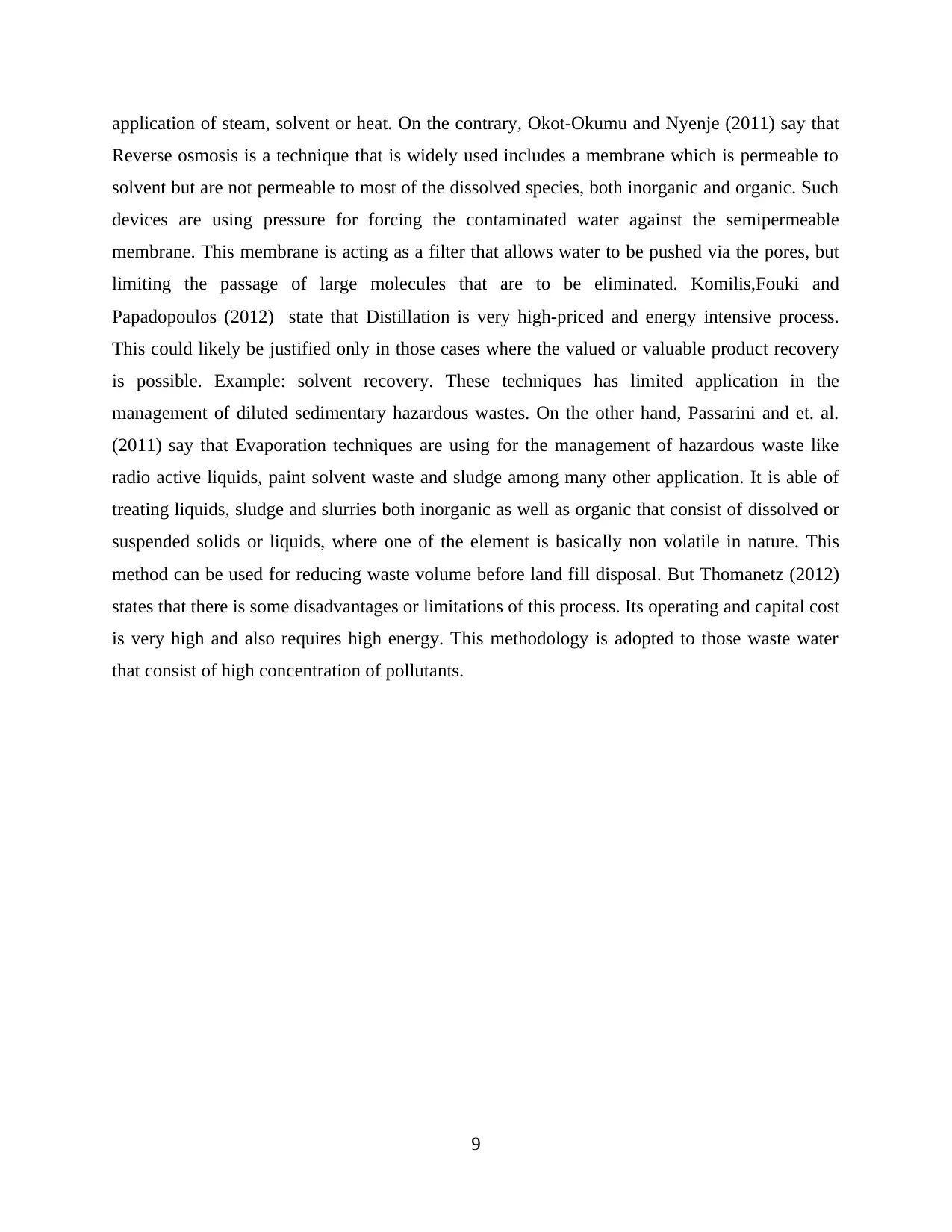
application of steam, solvent or heat. On the contrary, Okot-Okumu and Nyenje (2011) say that
Reverse osmosis is a technique that is widely used includes a membrane which is permeable to
solvent but are not permeable to most of the dissolved species, both inorganic and organic. Such
devices are using pressure for forcing the contaminated water against the semipermeable
membrane. This membrane is acting as a filter that allows water to be pushed via the pores, but
limiting the passage of large molecules that are to be eliminated. Komilis,Fouki and
Papadopoulos (2012) state that Distillation is very high-priced and energy intensive process.
This could likely be justified only in those cases where the valued or valuable product recovery
is possible. Example: solvent recovery. These techniques has limited application in the
management of diluted sedimentary hazardous wastes. On the other hand, Passarini and et. al.
(2011) say that Evaporation techniques are using for the management of hazardous waste like
radio active liquids, paint solvent waste and sludge among many other application. It is able of
treating liquids, sludge and slurries both inorganic as well as organic that consist of dissolved or
suspended solids or liquids, where one of the element is basically non volatile in nature. This
method can be used for reducing waste volume before land fill disposal. But Thomanetz (2012)
states that there is some disadvantages or limitations of this process. Its operating and capital cost
is very high and also requires high energy. This methodology is adopted to those waste water
that consist of high concentration of pollutants.
9
Reverse osmosis is a technique that is widely used includes a membrane which is permeable to
solvent but are not permeable to most of the dissolved species, both inorganic and organic. Such
devices are using pressure for forcing the contaminated water against the semipermeable
membrane. This membrane is acting as a filter that allows water to be pushed via the pores, but
limiting the passage of large molecules that are to be eliminated. Komilis,Fouki and
Papadopoulos (2012) state that Distillation is very high-priced and energy intensive process.
This could likely be justified only in those cases where the valued or valuable product recovery
is possible. Example: solvent recovery. These techniques has limited application in the
management of diluted sedimentary hazardous wastes. On the other hand, Passarini and et. al.
(2011) say that Evaporation techniques are using for the management of hazardous waste like
radio active liquids, paint solvent waste and sludge among many other application. It is able of
treating liquids, sludge and slurries both inorganic as well as organic that consist of dissolved or
suspended solids or liquids, where one of the element is basically non volatile in nature. This
method can be used for reducing waste volume before land fill disposal. But Thomanetz (2012)
states that there is some disadvantages or limitations of this process. Its operating and capital cost
is very high and also requires high energy. This methodology is adopted to those waste water
that consist of high concentration of pollutants.
9
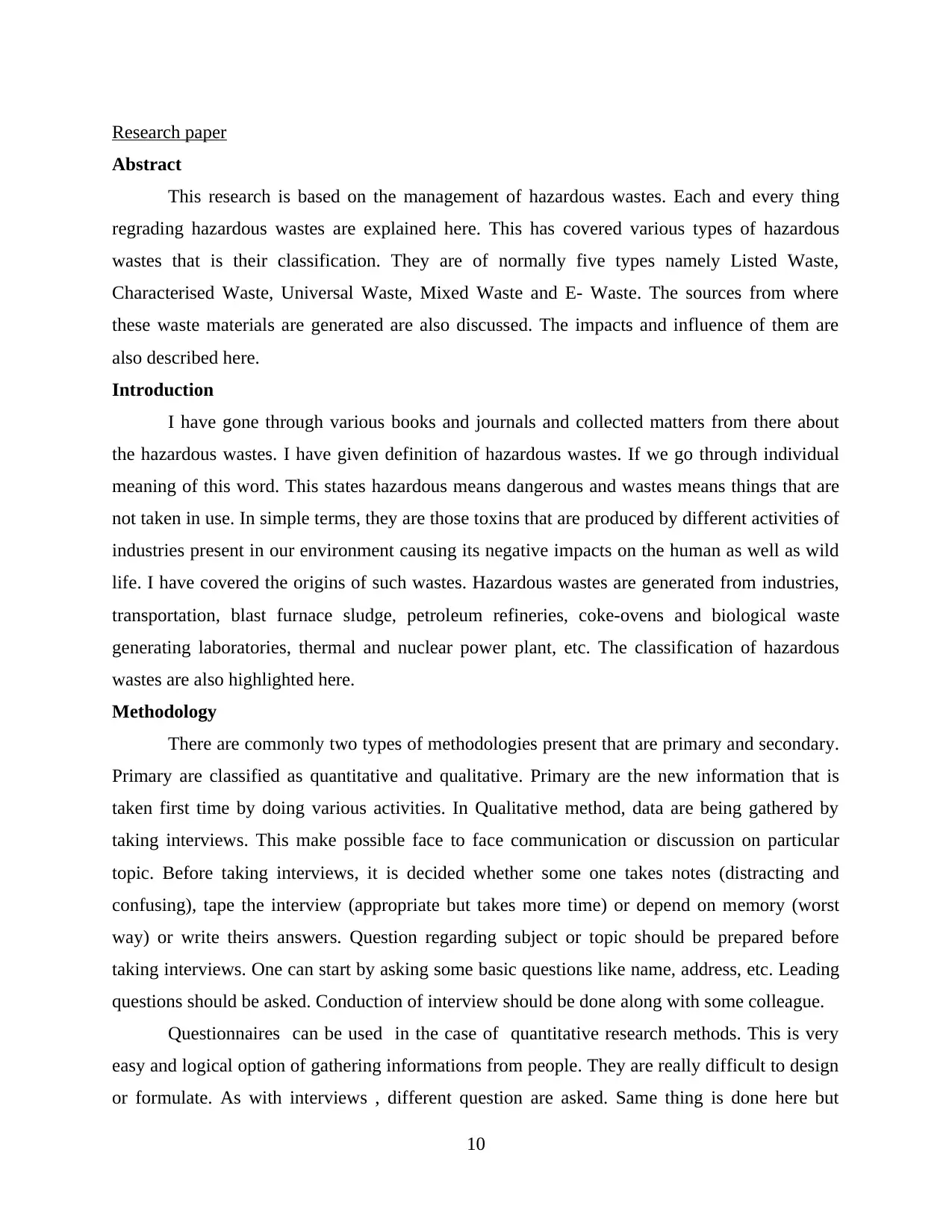
Research paper
Abstract
This research is based on the management of hazardous wastes. Each and every thing
regrading hazardous wastes are explained here. This has covered various types of hazardous
wastes that is their classification. They are of normally five types namely Listed Waste,
Characterised Waste, Universal Waste, Mixed Waste and E- Waste. The sources from where
these waste materials are generated are also discussed. The impacts and influence of them are
also described here.
Introduction
I have gone through various books and journals and collected matters from there about
the hazardous wastes. I have given definition of hazardous wastes. If we go through individual
meaning of this word. This states hazardous means dangerous and wastes means things that are
not taken in use. In simple terms, they are those toxins that are produced by different activities of
industries present in our environment causing its negative impacts on the human as well as wild
life. I have covered the origins of such wastes. Hazardous wastes are generated from industries,
transportation, blast furnace sludge, petroleum refineries, coke-ovens and biological waste
generating laboratories, thermal and nuclear power plant, etc. The classification of hazardous
wastes are also highlighted here.
Methodology
There are commonly two types of methodologies present that are primary and secondary.
Primary are classified as quantitative and qualitative. Primary are the new information that is
taken first time by doing various activities. In Qualitative method, data are being gathered by
taking interviews. This make possible face to face communication or discussion on particular
topic. Before taking interviews, it is decided whether some one takes notes (distracting and
confusing), tape the interview (appropriate but takes more time) or depend on memory (worst
way) or write theirs answers. Question regarding subject or topic should be prepared before
taking interviews. One can start by asking some basic questions like name, address, etc. Leading
questions should be asked. Conduction of interview should be done along with some colleague.
Questionnaires can be used in the case of quantitative research methods. This is very
easy and logical option of gathering informations from people. They are really difficult to design
or formulate. As with interviews , different question are asked. Same thing is done here but
10
Abstract
This research is based on the management of hazardous wastes. Each and every thing
regrading hazardous wastes are explained here. This has covered various types of hazardous
wastes that is their classification. They are of normally five types namely Listed Waste,
Characterised Waste, Universal Waste, Mixed Waste and E- Waste. The sources from where
these waste materials are generated are also discussed. The impacts and influence of them are
also described here.
Introduction
I have gone through various books and journals and collected matters from there about
the hazardous wastes. I have given definition of hazardous wastes. If we go through individual
meaning of this word. This states hazardous means dangerous and wastes means things that are
not taken in use. In simple terms, they are those toxins that are produced by different activities of
industries present in our environment causing its negative impacts on the human as well as wild
life. I have covered the origins of such wastes. Hazardous wastes are generated from industries,
transportation, blast furnace sludge, petroleum refineries, coke-ovens and biological waste
generating laboratories, thermal and nuclear power plant, etc. The classification of hazardous
wastes are also highlighted here.
Methodology
There are commonly two types of methodologies present that are primary and secondary.
Primary are classified as quantitative and qualitative. Primary are the new information that is
taken first time by doing various activities. In Qualitative method, data are being gathered by
taking interviews. This make possible face to face communication or discussion on particular
topic. Before taking interviews, it is decided whether some one takes notes (distracting and
confusing), tape the interview (appropriate but takes more time) or depend on memory (worst
way) or write theirs answers. Question regarding subject or topic should be prepared before
taking interviews. One can start by asking some basic questions like name, address, etc. Leading
questions should be asked. Conduction of interview should be done along with some colleague.
Questionnaires can be used in the case of quantitative research methods. This is very
easy and logical option of gathering informations from people. They are really difficult to design
or formulate. As with interviews , different question are asked. Same thing is done here but
10
⊘ This is a preview!⊘
Do you want full access?
Subscribe today to unlock all pages.

Trusted by 1+ million students worldwide
1 out of 16
Related Documents
Your All-in-One AI-Powered Toolkit for Academic Success.
+13062052269
info@desklib.com
Available 24*7 on WhatsApp / Email
![[object Object]](/_next/static/media/star-bottom.7253800d.svg)
Unlock your academic potential
Copyright © 2020–2025 A2Z Services. All Rights Reserved. Developed and managed by ZUCOL.



